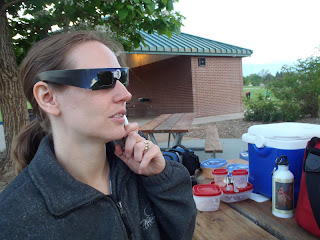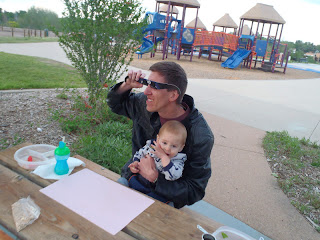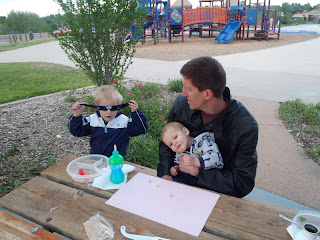Yesterday evening, we packed up our dinner as a picnic and headed out to a nearby park in order to watch the eclipse. It covered 80% of the sun at maximum viewing, which was only about 20 minutes before sunset. My parents were kind enough to pick us up some eclipse glasses a few days ago, so we had a safe way to watch.
Not a bad picture, considering all I did was aim my point-and-shoot camera through the eclipse glasses!
The weather was not ideal--partly cloudy, the sun kept popping in and out of clouds. Once the sliver of sun got thinner than this, my camera couldn't figure out what to focus on, especially since it was rapidly moving behind clouds as I tried to aim.
Zaxxon observed that the sun looked like the moon. We enjoyed examining its shape, and observing that first the crescent pointed down, and then as the eclipse began to wane, the crescent pointed left.
We found it amazing how powerful the sun still was. You couldn't tell at all, by trying to glance at the sun, that anything different was going on. Now, if it had been noon as opposed to nearly sunset and if it hadn't been cloudy, then perhaps the light would have dimmed enough to take notice of the change in light. However, we felt that we were nearly the only people at the park aware that anything special was going on overhead. The park was crowded--I think a soccer game had just ended--but we passed only two people we were certain were watching the eclipse. They had either a very small refractive telescope or a very large zoom for a camera, mounted on a tripod, aimed at the sun. I wanted to walk over and chat, but by the time I was ready to do so the sun had just set, and they walked off in the other direction. Oh well.
Don't I look cool in my eclipse shades?
Trying to keep Zaxxon eating while balancing an eleven-month-old on my lap (who kept sticking his fingers into my food) and periodically putting on the eclipse shades or trying to snap photos through them was quite an experience. I was actually reminded of a story by Connie Willis, which I looked up after we got home. It's called "And Come From Miles Around," which appeared in 1979. It's the story of a young mother who drove 700 miles with her husband, his coworker, and their two-year-old to watch a total solar eclipse. The weather threatens to be horrible but she figures out, based on things she saw whilst chasing the child around, that special visitors came to see the eclipse who would assure good weather during the show. I re-read it last night and felt kinship with the protagonist and her attempts to keep her daughter occupied.
The playground behind us helped to keep our brood occupied.
We had fun, and decided that perhaps we'll take a road trip in five years--the next time there's supposed to be a total eclipse in the USA. It would be neat to see the whole thing. As for something nearer, there's supposed to be a transit of Venus sometime in early June, and we're wondering if that will be visible without magnification through the eclipse glasses. I also wonder how expensive solar filters are for telescopes. If I can get something cheap, perhaps it's time to dust off my old six-inch reflector and have an astronomy party. One thing I'm not sure of though: how does one align a telescope to true north during the day when the north star isn't visible?








3 comments:
The pictures here look great. And that must have been some kind of task trying to do all those things with active toddlers to care for. Sounds like fun has had all around :-)
How fun! We didn't get glasses, so we had to look at it with the "punch a hole in a box" method. Got bored after 10 minutes. ;)
Could you align your telescope the night before and keep it covered during the day? Or does the North Star change a lot in 24 hours?
Post a Comment